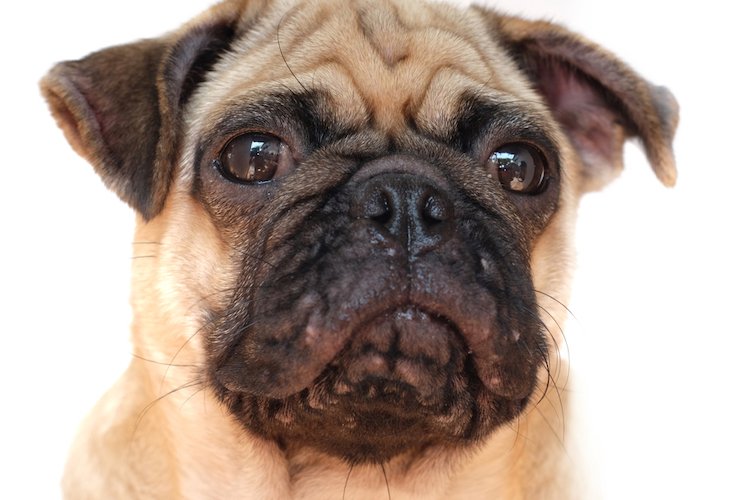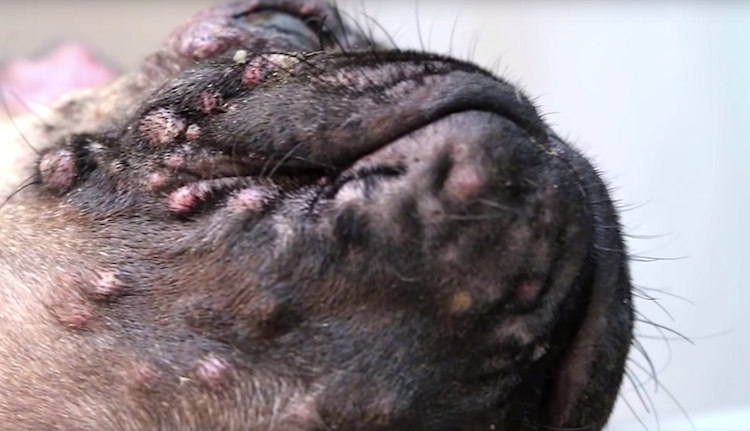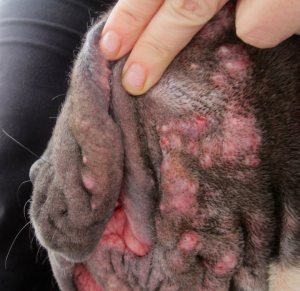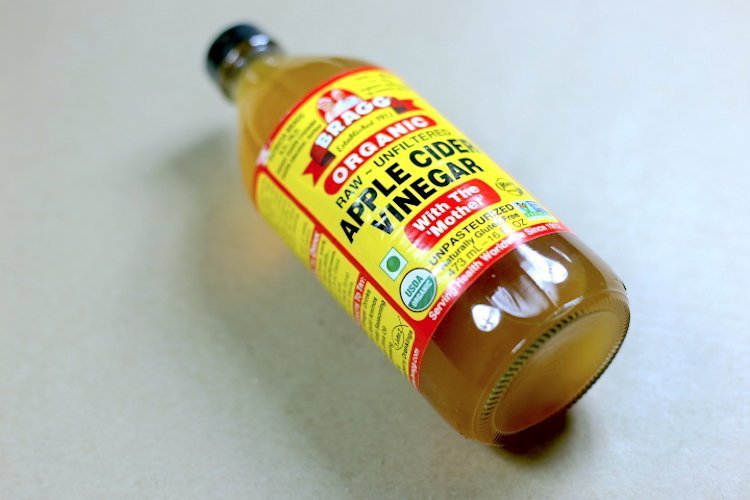
Can dogs get zits?
Yes, they sure can. (And cats can get zits, too.)
Dog pimples, zits, acne, plukes, spots … call them what you like, but pimples are definitely a canine thing.
Much like human acne affects teenagers, dog acne tends to affect young dogs. However, unlike in people, the cause of dog acne isn’t hormonal but more down to hygiene and genetics.
In this expert guide, we’ll discuss:
- How long do dog pimples last?
- Can I pop a pimple on my dog?
- What’s a good dog acne shampoo?
- Are there dog acne home remedies?
But first, crucial to clearing up dog pimples is understanding why they happen in the first place.

Acne Disorders in Dogs
It’s the youngsters who get dog acne.
Think of a bumbling puppy in that oh-so-cute 3- to 12-month age bracket, and these are the guys most likely to get dog pimples.
The most common place for dog acne is on the muzzle and lips. Some dogs also get spots on the belly, but this tends not to be labeled as acne but more as a spotty tummy. (See my article on hyperpigmentation in dogs.)
Oh, and another quirk is that short-coated dogs are more prone to acne — the reason for which will soon become clear.
Can Dogs Get Zits?
Yes, and here’s why dogs get pimples on their body …
What do dogs love to do? They investigate everything with their mouth, that’s what.
All that sniffing, chewing, rubbing and biting is hard work for an inquisitive muzzle.
Research now suggests that a playful puppy who is rubbing their chin on a hard surface causes damage to the hairs:
- If these hairs snap off below the skin surface, that sharp bristle causes the hair follicle to inflame.
- With the hair follicle damaged by inflammation, this gives bacteria an open invitation to invade. With lots of bacteria hanging around the broken hair shaft, this is the perfect recipe for dog acne to develop.
- If the spot gets big enough, it ruptures, which leads to a weeping sore. This is also itchy, which leads to a vicious circle of more rubbing, more broken hairs and more dog pimples.
Breed Predisposition to Dog Pimples
Some dogs just have the odds stacked against them because of their breed.
Here are some of the dog breeds predisposed to dog pimples:
These breeds have a genetic predisposition, inherited from their parents, for developing acne.
Was YOUR Pet Food Recalled?
Check Now: Blue Buffalo • Science Diet • Purina • Wellness • 4health • Canine Carry Outs • Friskies • Taste of the Wild • See 200+ more brands…

It’s also interesting to note that most of these dogs are short coated. This fits with what we now know about broken hair shafts inflaming the follicles.

What Does Dog Acne Look Like?
Let’s say your dog has bumps on the chin and around the mouth — that could very well be acne.
Classic dog acne affects the dog’s muzzle, particularly the chin and lips.
Mild acne looks like raised red bumps on the skin. Be sure to look closely: Sometimes the bumps that whiskers grow from, which are perfectly normal, can be mistaken for acne spots.
What Is a Pustule on a Dog?
If those red bumps come to a head, they become whiteheads or the all-too-familiar pimple (more correctly called a pustule). This can be sterile (no bacteria present) or infected (contains bacteria).
Severe acne with lots of dog pimples causes general soreness and swelling. This inflammation makes the skin of the lips and muzzle swell, giving them a fat face.
If the dog then rubs (and who wouldn’t?), the zits burst and continued rubbing turns them into bleeding wounds.
Dog acne bleeding requires veterinary attention to prevent scarring, because continued rubbing leads to permanent scar tissue.
Can I Pop a Pimple on My Dog?
No, popping your dog’s pimples is not a good idea.
Bursting those zits may be tempting, but it’s also traumatic to the skin and does more harm than good.
So resist temptation. Instead, try one of the treatment options listed below.
But, it needs to be said, seeing a veterinarian is important. Never assume the problem is simple dog acne, because the problem can be complex.
Skin immunity plays a big part in preventing acne. If the dog’s immune system is weak, there may be another more serious condition that needs investigating. The acne then becomes a symptom of a bigger problem, rather than a diagnosis in its own right.
Examples of these predisposing factors include allergy, ringworm or Demodex mites. Either way, a correct diagnosis makes the difference between the treatment working or not.
OK, for those already with a diagnosis of uncomplicated dog pimples, now we will talk about treatments and solutions for dog acne.
Dog Acne Treatments
You can’t do anything about the dog’s age or breed (both of those things predispose the dog to acne), but you can help their personal hygiene.
Follicle Flushing
Follicle flushing means washing out those dirty hair follicles to keep them sparkling clean. The idea is to remove the bacteria that cause infection and to stop those pimples from developing.
This way, when you resist pimple popping and once the inflammation settles down, there’s no evidence the dog ever had a spot.
Follicle flushing is done using medicated shampoo. So what’s the best dog acne shampoo?
Look for a dog acne shampoo that contains benzyl peroxide. Yes, this may sound familiar from human acne treatments, but do not use the human version of the shampoo. It’s far too strong and burns dog skin, giving a new set of different problems.
You can use a dog acne shampoo in a similar way a teenager uses a facial wash: Wet the dog’s skin, work in a bit of shampoo and then rinse well.
Dog Acne and Antibiotics
If the acne is particularly bad or there are bleeding spots, the vet may prescribe antibiotics.
The most common bacteria causing canine acne are the Staphylococcus group, since these are normal residents on the surface of canine skin. Using a good broad-spectrum antibiotic, especially in a dog who’s never had antibiotics before, is likely to do the trick.
If the acne keeps flaring up, the vet may then suggest swabbing the skin, to harvest some of the bacteria for culture. This allows for targeted antibiotic usage so the bacteria don’t stand a chance.
The antibiotics are usually taken by mouth rather than applied as an ointment. The therapy needs to work from the inside out in order to be effective.
A long course of several weeks may also be needed. Stopping therapy too early can run the risk of a relapse.
Dog Acne and Steroids
If the swelling is particularly bad or the dog just can’t stop scratching, the vet may suggest steroids.
This may either be a topical gel, injection or tablets.
The idea is to reduce the swelling and give the dog relief from the discomfort. By reducing the urge to itch, the dog is less likely to damage themselves, which allows things to settle down.
Of course, using steroids in young dogs is not ideal. Which means it makes even more sense to tackle the pimples early when it’s easier to soothe things away.
How Long Do Dog Pimples Last?
Even with medication, it can take 4–12 weeks for severe acne to settle down.
But the good news is that individual pimples will be gone in a matter of days or weeks. So if you can keep the skin clean, there’s a good chance things will look up soon.
And for those who prefer to try natural remedies, below are some options to try.

How to Get Rid of Dog Acne the Natural Way
The first option is common sense, and it’s cleanliness.
If your dog gets a grubby chin from rooting around in dirt, give the dog a bath. This doesn’t have to be a full scale shower — a clean, moist facecloth around the chops should do the trick.
Do Not Use Coconut Oil for Dog Acne
On the plus side, coconut oil has mild natural antibiotic and antiseptic qualities. Great.
But …
On the minus side, this is an oil, so plugging the follicles with a greasy substance could actually feed the bacteria. Given that the antibacterial action is weak, the cons probably out weight the pros. This is why I do not recommend using coconut oil for dog acne.
But don’t despair, because there are other natural remedies to try.
Apple Cider Vinegar (ACV)
- Dilute the apple cider vinegar to half strength using warm water.
- Soak some cotton wool with this diluted solution and use it to wipe the dog’s chin clean.
This makes the most of ACV’s mild antimicrobial and antiseptic properties.
ACV is most effective when used as a preventive measure in acne-prone dogs rather than as a treatment for a full-scale acne flare-up.
Green Tea
Among its beneficial properties, green tea is mildly astringent when applied to the skin. It’s also said to have some anti-itch properties, which relieve the dog’s need to scratch.
- Make the tea as normal and leave it to cool.
- Then apply topically: Soak some cotton wool in the tea and wipe your dog’s chin clean.
Aloe Vera
Known for its antibacterial and soothing properties, aloe vera gel can calm sensitized skin. Apply after bathing the dog’s chin.
Aloe vera has the added benefit of hydrating the skin, which may be dried out by washing.
Nettle
Nettle infusion is an old remedy used for alleviating the discomfort caused by conditions such as eczema and acne.
Calendula
This is another traditional remedy to aid skin healing.
- Use a tincture of Calendula, diluting about 6 drops in 1 ounce of water.
- Use this to moisten some cotton wool, and then bathe the dog’s chin as before.

Final Thoughts on Dog Pimples
Dog acne has different causes from those leading to human acne.
Good hygiene makes a big difference, but sadly, acne could just be in your dog’s genes.
Get a spotty pup checked out by the vet. Fingers crossed it’s just a matter of using a medicated wash, but sometimes antibiotics are necessary.
But whatever you do, do not start popping your dog’s pimples — that can lead to scar tissue.
References
- Barnette, Catherine, DVM. “Acne in Dogs.” VCA Hospitals. 2017. https://vcahospitals.com/know-your-pet/acne-in-dogs.
- Spiegel, Ian B., VMD, MHS, DACVD. “Just Ask the Expert: How Do You Manage Canine Chin Acne?” dvm360. Feb. 1, 2011. http://veterinarymedicine.dvm360.com/just-ask-expert-how-do-you-manage-canine-chin-acne.
- Moriello, Karen A., DVM, DACVD. “Overview of Pyoderma.” Merck Veterinary Manual. https://www.msdvetmanual.com/integumentary-system/pyoderma/overview-of-pyoderma.
 This pet health content was written by a veterinarian, Dr. Pippa Elliott, BVMS, MRCVS. It was last reviewed April 5, 2022.
This pet health content was written by a veterinarian, Dr. Pippa Elliott, BVMS, MRCVS. It was last reviewed April 5, 2022. 

